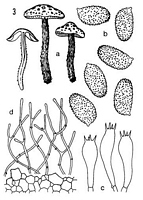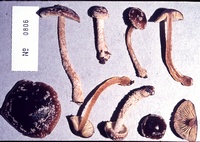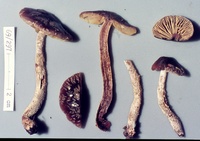|
 Cortinarius phaeomyxa Cortinarius phaeomyxa
SynonymsCuphocybe phaeomyxa
BiostatusPresent in region - Indigenous. Endemic
Images (click to enlarge)
Caption: Cuphocybe phaeomyxa
Horak (holotype): a. carpophores. b. spores.
c. basidia. d. cuticle | 
Caption: ZT0806
Owner: E. Horak: © Creative Commons Attribution-Noncommercial 3.0 New Zealand | 
Caption: ZT69-297, Holotype
Owner: E. Horak: © Creative Commons Attribution-Noncommercial 3.0 New Zealand |
Article: Horak, E. (1973). Fungi Agaricini Novazelandiae I-V. Beihefte zur Nova Hedwigia 43: 200 p.
Description: Pileus
15-30 mm diam., convex to umbonate, date brown to umber brown, glutinous when
wet, covered with numerous, small, ochraceous squamules swimming in the slime.
Lamellae waxy, straminous, turning ochraceous, adnexed, ventricose, gill edge
concolorous, even. Stipe 35-55 x 34 mm, cylindric, equal or subfusoid, whitish
or brownish, densely covered with dry, ochraceous longitudinal fibrils becoming
squarrose towards the base, cortina absent, single, hollow. Context brown. Odor
and taste not distinctive. Chemical reactions on pileus: KOH, HCl and NH3
- negative.
Spore
print ochraceous-brown. Spores 12-14.5 x 7-8 µm, ellipsoid, ferruginous, densely
covered with isolated warts; germ pore or plage absent. Basidia 35-45 x 10-12
µm, 4-spored. Cystidia lacking. Cuticle consisting of strongly gelatinized,
densely woven, cylindric, hyaline hyphae (2-6 µm diam.) forming an ixocutis,
subcutis subcellular, membranes encrusted with brown pigment. Clamp connections
numerous
Habitat: Amongst
litter under Nothofagus fusca and N. menziesii. New Zealand
Notes: This
species is easily recognized by its glutinous pileus and the deep brown colours.
In spite of the wax-yellow lamellae and the lack of a marginate bulb on the
stipe this taxon undoubtedly belongs to the genus Cuphocybe. Aged carpophores
resemble macroscopically Descolea phlebophora Horak or Descolea gunnii
(Berkeley).
|